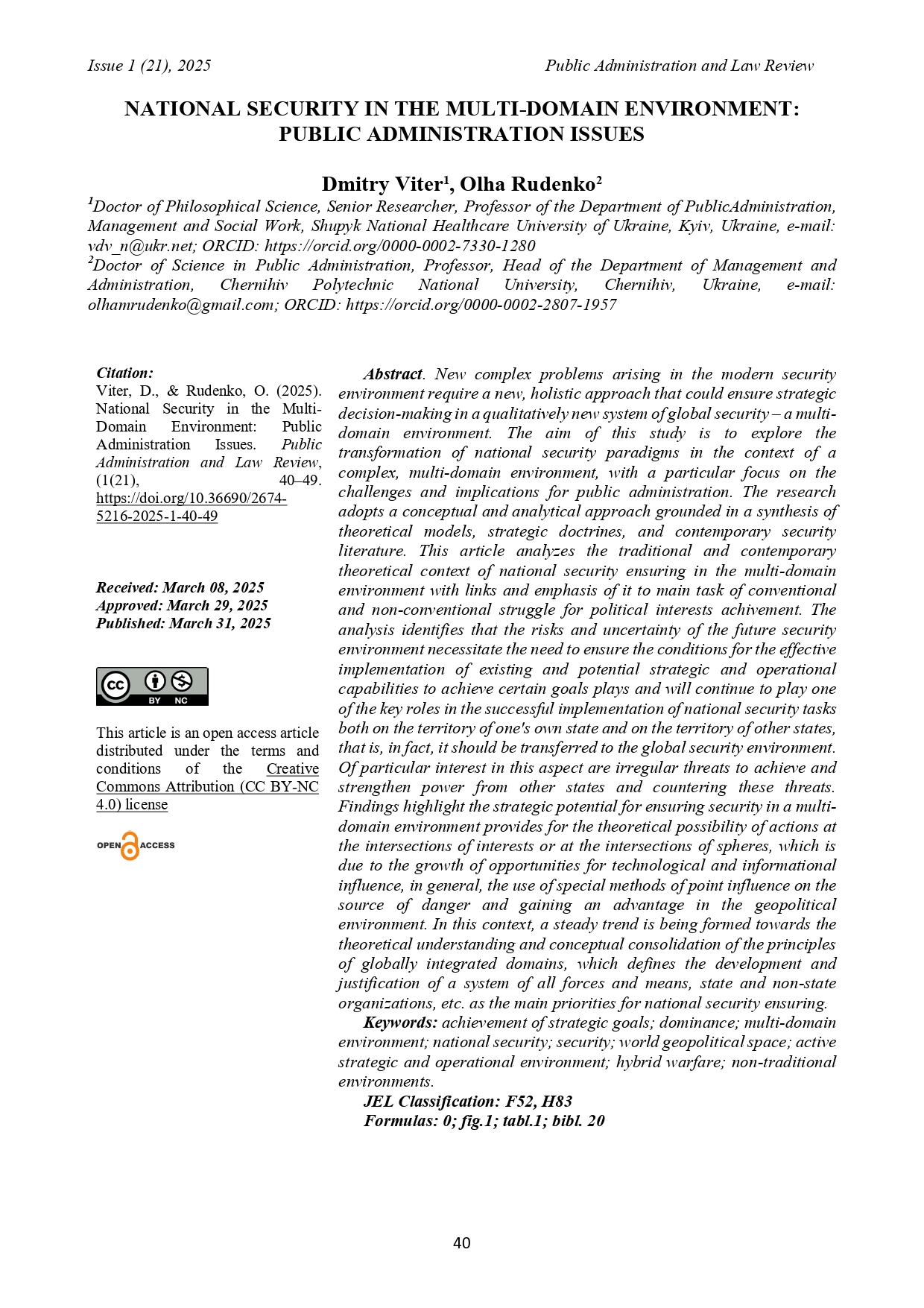NATIONAL SECURITY IN THE MULTI-DOMAIN ENVIRONMENT: PUBLIC ADMINISTRATION ISSUES
DOI:
https://doi.org/10.36690/2674-5216-2025-1-40-49Keywords:
achievement of strategic goals, dominance, multi-domain environment, national security, security, world geopolitical space, active strategic and operational environment, hybrid warfare, non-traditional environmentsAbstract
New complex problems arising in the modern security environment require a new, holistic approach that could ensure strategic decision-making in a qualitatively new system of global security – a multi-domain environment. The aim of this study is to explore the transformation of national security paradigms in the context of a complex, multi-domain environment, with a particular focus on the challenges and implications for public administration. The research adopts a conceptual and analytical approach grounded in a synthesis of theoretical models, strategic doctrines, and contemporary security literature. This article analyzes the traditional and contemporary theoretical context of national security ensuring in the multi-domain environment with links and emphasis of it to main task of conventional and non-conventional struggle for political interests achivement. The analysis identifies that the risks and uncertainty of the future security environment necessitate the need to ensure the conditions for the effective implementation of existing and potential strategic and operational capabilities to achieve certain goals plays and will continue to play one of the key roles in the successful implementation of national security tasks both on the territory of one's own state and on the territory of other states, that is, in fact, it should be transferred to the global security environment. Of particular interest in this aspect are irregular threats to achieve and strengthen power from other states and countering these threats. Findings highlight the strategic potential for ensuring security in a multi-domain environment provides for the theoretical possibility of actions at the intersections of interests or at the intersections of spheres, which is due to the growth of opportunities for technological and informational influence, in general, the use of special methods of point influence on the source of danger and gaining an advantage in the geopolitical environment. In this context, a steady trend is being formed towards the theoretical understanding and conceptual consolidation of the principles of globally integrated domains, which defines the development and justification of a system of all forces and means, state and non-state organizations, etc. as the main priorities for national security ensuring.
Downloads
References
Boustras, G. & Waring A. (2020). Towards a reconceptualization of safety and security, their interactions, and policy requirements in a 21st century context. Safety Science., 132, p. 104942. 10.1016/j.ssci.2020.104942.
Clarke, M., Henschke, A., Legrand, T. & Sussex, M. (2022). National Security: Theories, Actors, Issues. In: The Palgrave Handbook of National Security. Palgrave Macmillan, Cham.
Dekker, S. (2015). Safety differently: human factors for a new era (ed), CRC Press, Taylor & Francis Group.
Deterrence Operations. Joint Operating Concept, Version 2.0, December 2006. USA: Office of Primary Responsibility.
Donnelly, J. & Farley, J. (2019). Defining the ‘Domain’ in Multi-Domain. Joint Air & Space Power Conference 2019. Read Ahead. The Joint Air Power Competence Centre von-Seydlitz-Kaserne, P. 7-15.
El-Muhammady, A. (2021). Balancing national development, national security, and cybersecurity policy. Routledge.
Galula, D. (2006). Counterinsurgency Warfare: Theory and Practice. Praeger Security International.
GTA 31-03-003, Special Forces Detachment Mission Planning Guide (2020). US Headquarters, Department of the Army.
Joint Concept Note 1/20 Multi-Domain Integration. 2020. UK, Ministry of Defence.
Kitler, W. (2021). National security theory and practice. The Publishing House of the Society of Defence Knowledg.
Le Coze, J. (2020). Ideas for the future of safety science. Safety Science. Vol. 132. https://doi.org/10.1016/j.ssci.2020.104966.
Mandel, D. & Irwin, D. (2021). Uncertainty, Intelligence, and National Security Decisionmaking. International Journal of Intelligence and Counter Intelligence, 34(3): 558-582.
Nettis, M. (2020). Multi-Domain Operations: Bridging the Gaps for Dominance. Wild Blue Yonder. Online Journal. https://www.airuniversity.af.edu/Wild-Blue-Yonder/Articles/Article-Display/Article/2109784/multi-domain-operations-bridging-the-gaps-for-dominance/#sdendnote15sym.
Radvani, J. (1990). Psychological Operations and Political Warfarein Long-Term Strategic Planning. Praeger.
Saur, H. Multi-Domain Combat Cloud: A Vision for the Future Battlefield. In: 7-9 September 2021 Read-Ahead for Delivering NATO Air and Space Power at the Speed of Relevance. – www.japcc.org.
Sussex, M., Clarke, M. & Medcalf, R. (2017). National security: between theory and practice, Australian Journal of International Affairs, 71:5, 474-478, DOI: 10.1080/10357718.2017.1347139.
The U.S. Army in Multi-Domain Operations 2028. TRADOC Pamphlet 525-3-1. 6 December 2018.
Townsend, S., gen. (2019). Accelerating Multi-Domain Operations: Evolution of an Idea. In Shaping NATO for Multi-Domain Operations of the Future: Joint Air & Space Power Conference 2019. Read Ahead. 7-12.
Wu, C. & Wang, B. (2023). Theory of creating new disciplines of safety and security (SS) science and essentials of 40 practical examples. Emergency Management Science and Technology 3:2 https://doi.org/10.48130/EMST-2023-0002.
Wu, C., Wang, B. & Xie, Y. (2019). Further research on safety reduced-dimension theory. Safety & Security. 40(11). pp. 40-46.

Downloads
Published
How to Cite
Issue
Section
License

This work is licensed under a Creative Commons Attribution-NoDerivatives 4.0 International License.





